.
Administrative Region : North Aegean
Regional unit : Samos
Samos (Greek: Σάμος) is a Greek island in the eastern Aegean Sea, south of Chios, north of Patmos and the Dodecanese, and off the coast of Asia Minor, from which it is separated by the 1.6 kilometres (0.99 mi)-wide Mycale Strait. It is also a separate regional unit of the North Aegean region, and the only municipality of the regional unit.
In ancient times Samos was a particularly rich and powerful city-state. It is home to Pythagoreion and the Heraion of Samos, a UNESCO World Heritage Site that includes the Eupalinian aqueduct, a marvel of ancient engineering. Samos is the birthplace of the Greek philosopher and mathematician Pythagoras, after whom the Pythagorean theorem is named, the philosopher Epicurus, and the astronomer Aristarchus of Samos, the first known individual to propose that the Earth revolves around the sun. Samian wine was well known in antiquity, and is still produced on the island.
The island was an autonomous principality from 1835 until it joined Greece in 1912.
Geography and Climate
NASA Satellite 3D view of Samos.
Psalida Beach. At the distant background Mount Kerketeas.
View of Poseidonio.
The area of the island is 478 km2 (184.6 sq mi) 43 km (27 mi) long and 13 km (8 mi) wide. It is separated from Anatolia, by the approximately 1 mile (1.6 km)-wide Mycale Strait. While largely mountainous, Samos has several relatively large and fertile plains.
A great portion of the island is covered with vineyards, from which muscat wine is made. The most important plains except the capital, Vathy, in the northeast, are that of Karlovasi, in the northwest, Pythagoreio, in the southeast, and Marathokampos in the southwest. The island's population is 33,814, which is the 9th most populous of the Greek islands. The Samian climate is typically Mediterranean, with mild rainy winters, and warm rainless summers.
Samos' relief is dominated by two large mountains, Ampelos and Kerkis (anc. Kerketeus). The Ampelos massif (colloquially referred to as "Karvounis") is the larger of the two and occupies the center of the island, rising to 1,095 metres (3,593 ft). Mt. Kerkis, though smaller in area is the taller of the two and its summit is the island's highest point, at 1,434 metres (4,705 ft). The mountains are a continuation of the Mycale range on the Anatolian mainland.
According to Strabo, the name Samos is from Phoenician meaning "rise by the shore."
Samos is one of the sunniest places in Europe with almost 3300 hours of sunshine annually or 74% of the time.
| Climate data for Vathy, Samos, Greece | |||||||||||||
|---|---|---|---|---|---|---|---|---|---|---|---|---|---|
| Month | Jan | Feb | Mar | Apr | May | Jun | Jul | Aug | Sep | Oct | Nov | Dec | Year |
| Average high °C (°F) | 12 (54) |
13 (55) |
15 (59) |
19 (66) |
24 (75) |
29 (84) |
31 (88) |
31 (88) |
28 (82) |
22 (72) |
18 (64) |
14 (57) |
21 (70) |
| Average low °C (°F) | 5 (41) |
6 (43) |
7 (45) |
10 (50) |
13 (55) |
17 (63) |
20 (68) |
20 (68) |
17 (63) |
13 (55) |
10 (50) |
7 (45) |
12 (54) |
| Precipitation mm (inches) | 159 (6.26) |
108 (4.25) |
88 (3.46) |
42 (1.65) |
28 (1.1) |
6 (0.24) |
3 (0.12) |
3 (0.12) |
18 (0.71) |
42 (1.65) |
103 (4.06) |
167 (6.57) |
767 (30.2) |
| Avg. precipitation days | 12 | 11 | 9 | 8 | 6 | 3 | 4 | 4 | 3 | 6 | 8 | 13 | 87 |
| Sunshine hours | 155 | 170 | 217 | 270 | 341 | 390 | 434 | 403 | 330 | 248 | 180 | 155 | 3,293 |
| Source: weather2travel.com[1] | |||||||||||||
History
Early and Classical Antiquity
Further information: Ancient Greece
Kouros of Samos, the largest surviving Kouros in Greece (Archaeological Museum of Samos).
In classical antiquity the island was a center of Ionian culture and luxury, renowned for its Samian wines and its red pottery (called Samian ware by the Romans). Its most famous building, was the Ionic order archaic Temple of goddess Hera - the Heraion.
Concerning the earliest history of Samos, literary tradition is singularly defective. At the time of the great migrations it received an Ionian population which traced its origin to Epidaurus in Argolis: Samos became one of the twelve members of the Ionian League. By the 7th century BC it had become one of the leading commercial centers of Greece. This early prosperity of the Samians seems largely due to the island's position near trade-routes, which facilitated the importation of textiles from inner Asia Minor, but the Samians also developed an extensive oversea commerce. They helped to open up trade with the population that lived around the Black sea as well as with Egypt, Cyrene (Libya), Corinth, and Chalcis. This caused them to become bitter rivals with Miletus. Samos was able to become so prominent despite the growing power of the Persian empire because of the alliance they had with the Egyptians and their powerful fleet. The Samians are also credited with having been the first Greeks to reach the Straits of Gibraltar.[2]
The feud between Miletus and Samos broke out into open strife during the Lelantine War (7th century BC), with which we may connect a Samian innovation in Greek naval warfare, the use of the trireme. The result of this conflict was to confirm the supremacy of the Milesians in eastern waters for the time being; but in the 6th century the insular position of Samos preserved it from those aggressions at the hands of Asiatic kings to which Miletus was henceforth exposed. About 535 BC, when the existing oligarchy was overturned by the tyrant Polycrates, Samos reached the height of its prosperity. Its navy not only protected it from invasion, but ruled supreme in Aegean waters. The city was beautified with public works, and its school, of sculptors, metal-workers and engineers achieved high repute.

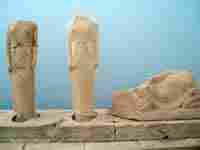

Eupalinian aqueduct
Main article: Tunnel of Eupalinos
Inside the Eupalinian aqueduct.
In the 6th century BC Samos was ruled by the famous tyrant Polycrates. During his reign, two working groups under the lead of the engineer Eupalinos dug a tunnel through Mount Kastro to build an aqueduct to supply the ancient capital of Samos with fresh water, as this was of the utmost defensive importance (since being underground, it was not easily detected by an enemy who could otherwise cut off the supply). Eupalinos' tunnel is particularly notable because it is the second earliest tunnel in history to be dug from both ends in a methodical manner.[3] With a length of over 1 km, Eupalinos' subterranean aqueduct is today regarded as one of the masterpieces of ancient engineering. The aqueduct is now part of the UNESCO World Heritage Site, the Pythagoreion.
Persian Wars and Persian rule
After Polycrates death Samos suffered a severe blow when the Persian Achaemenid Empire conquered and partly depopulated the island. It had regained much of its power when in 499 BC it joined the general revolt of the Ionian city-states against Persia; but owing to its long-standing jealousy of Miletus it rendered indifferent service, and at the decisive battle of Lade (494 BC) part of its contingent of sixty ships was guilty of outright treachery. In 479 BC the Samians led the revolt against Persia, during the Battle of Mycale, which was part of the offensive by the Delian League (led by Cimon).
Peloponnesian War
During the Peloponnesian War (431–404 BC), Samos took the side of Athens against Sparta, providing their port to the Athenian fleet. In the Delian League they held a position of special privilege and remained actively loyal to Athens until 440 when a dispute with Miletus, which the Athenians had decided against them, induced them to secede. With a fleet of sixty ships they held their own for some time against a large Athenian fleet led by Pericles himself, but after a protracted siege were forced to capitulate. It was punished, but Thucydides tells us not as harshly as other states which rebelled against Athens. Most in the past had been forced to pay tribute but Samos was only told to repay the damages that the rebellion cost the Athenians: 1,300 talents, to pay back in installments of 50 talents per annum.
At the end of the Peloponnesian War, Samos appears as one of the most loyal dependencies of Athens, serving as a base for the naval war against the Peloponnesians and as a temporary home of the Athenian democracy during the revolution of the Four Hundred at Athens (411 BC), and in the last stage of the war was rewarded with the Athenian franchise. This friendly attitude towards Athens was the result of a series of political revolutions which ended in the establishment of a democracy. After the downfall of Athens, Samos was besieged by Lysander and again placed under an oligarchy.
In 394 the withdrawal of the Spartan navy induced the island to declare its independence and reestablish a democracy, but by the peace of Antalcidas (387) it fell again under Persian dominion. It was recovered by the Athenians in 366 after a siege of eleven months, and received a strong body of military settlers, the cleruchs which proved vital in the Social War (357-355 BC). After the Lamian War (322), when Athens was deprived of Samos, the vicissitudes of the island can no longer be followed.
Famous Samians of Antiquity
Panorama of Pythagoreion, the place of birth of Pythagoras.
Perhaps the most famous persons ever connected with classical Samos were the philosopher Pythagoras and Aesop. In 1955 the town of Tigani was renamed Pythagoreio in honor of the philosopher.
Other notable personalities include the philosopher Epicurus, who was of Samian birth and the astronomer Aristarchus of Samos, whom history credits with the first recorded heliocentric model of the solar system. The historian Herodotus, known by his Histories resided in Samos for a while.
There was a school of sculptors and architects that included Rhoecus, the architect of the Temple of Hera (Olympia), and the great sculptor and inventor Theodorus, who is said to have invented with Rhoecus the art of casting statues in bronze.
The vases of Samos were among the most characteristic products of Ionian pottery in the 6th century.
Hellenistic & Roman Eras
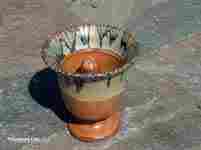
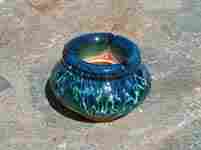

Main articles: Hellenistic Greece and Roman Greece
For some time (about 275-270 B.C.) Samos served as a base for the Egyptian fleet of the Ptolemies, at other periods it recognized the overlordship of Seleucid Syria. In 189 B.C. it was transferred by the Romans to their vassal, the Attalid dynasty's Hellenistic kingdom of Pergamon, in Asia Minor.
Enrolled from 133 in the Roman province of Asia Minor, Samos sided with Aristonicus (132) and Mithridates (88) against its overlord, and consequently forfeited its autonomy, which it only temporarily recovered between the reigns of Augustus and Vespasian. Nevertheless, Samos remained comparatively flourishing, and was able to contest with Smyrna and Ephesus the title first city of lonia; it was chiefly noted as a health resort and for the manufacture of pottery. Since Emperor Diocletian's Tetrarchy it became part of the Provincia Insularum, in the diocese of Asiana in the eastern empire's pretorian prefecture of Oriens.
Byzantine & Genoese Eras
Further information: Byzantine Greece and Republic of Genoa
The harbour of Pythagoreion.
As part of the Byzantine Empire, Samos became part of the namesake theme. After the 13th century it passed through much the same changes of government as Chios, and, like the latter island, became the property of the Genoese firm of Giustiniani (1346–1566; 1475 interrupted by an Ottoman period).
Ottoman Rule
Further information: Ottoman Greece
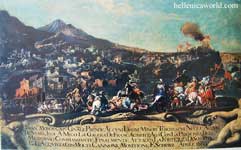
During the early years of the Ottoman Empire most Samians abandoned the island[CN]. Those remaining lived inland in small settlements up in the mountains, hiding from pirates and other invaders. Around the 17th century Samos was granted the status of a semi-independent state. Many Greeks of Samian descent as well as others from Greek speaking territories settled on the island. The village of Mytilinioi for example, was inhabited by people from the island of Mytilini. Other settlers followed from various provinces in mainland Greece and as far away as Albania. A substantial population came from Ipiros and therefore the accent of the Samians even till the present day resembles that of mainland Greece. Samos, (Ottoman Turkish: سيسام Sisam) belonged to the Ottoman Empire since 1533, as part of the Eyalet of Djeza'ir-i Bahr-i Sefid i.e. "of the White Sea" (Mediterranean) until the year 1821.
Greek Revolution
Flag of the Administration of Samos during the Greek War of Independence (1821-1830).
During the Greek War of Independence, Samos played a conspicuous part, setting up a revolutionary government under the following heads of local government:
18 April 1821 - April 1821 Konstantinos Lachanas
April 1821 - April 1828 Lykourgos Logothetis (1st time)
April 1828 - February 1829 Ioannis Kolettis (1st time)
February 1829 - October 1829 Dimitrios Christides
October 1829 - July 1830 Ioannis Kolettis (2nd time)
July 1830 - 1833 Lykourgos Logothetis (2nd time)
In July 1824, an Ottoman army assembled to invade the island, but Greek naval victories off Samos and at Gerontas averted the threat. The island remained free for the remainder of the war. Nevertheless, the treaties concluding the war, which established the independent Greek kingdom, again put Samos under Turkish suzerainty.
The autonomous Principality
Main article: Principality of Samos
Flag of the Principality of Samos. It is the old Greek flag with the two upper quadrants in red to symbolize Ottoman suzerainty.
In 1835, the Samians achieved self-government as a semi-independent state tributary to Ottoman Turkey, paying the annual sum of £2700.[4] It was governed by a Christian of Greek descent though nominated by the Porte, who bore the title of "Prince." The prince was assisted in his function as chief executive by a 4-member senate. These were chosen by him out of eight candidates nominated by the four districts of the island: Vathý, Khōra, Marathókampos, and Karlóvasi. The actual legislative power belonged to a chamber of 36 deputies, presided over by the Greek Orthodox Metropolitan. The seat of the government was the port of Vathý.
The modern capital of the island was, until the early 20th century, at Khora, about 2 miles (3.2 km) from the sea and from the site of the ancient city.
After reconsidering political conditions, the capital was moved to Vathý, at the head of a deep bay on the North coast. This became the residence of the prince and the seat of government.
Since then a new town has grown, with a harbour.
Modern Era
The union with the Kingdom of Greece in 1912.
The island was finally united with the Kingdom of Greece in 1912, with the outbreak of the Balkan Wars. During World War II, the island was occupied by Italian and later German troops.
On August 3, 1989, a Shorts 330 aircraft of the Olympic Airways (now Olympic Airlines) crashed near Samos Airport; thirty-one passengers died.
Government
Samos is a separate regional unit of the North Aegean region, and the only municipality of the regional unit. As a part of the 2011 Kallikratis government reform, the regional unit Samos was created out of part of the former Samos Prefecture. At the same reform, the current municipality Samos was created out of the 4 former municipalities: [5]
Karlovasi
Marathokampos
Pythagoreio
Vathy
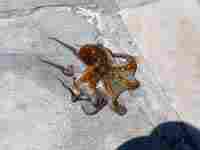

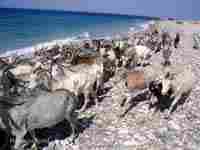
Samos has a sister town called Samo, which is located in Calabria, Italy.
Economy
The Samian economy depends mainly on agriculture[CN] and the tourist industry which has been growing steadily since the early 1980s. The main agricultural products include grapes, honey, olives, olive oil, citrus fruit, dried figs and almonds, and flowers. The Muscat grape is the main crop used for wine production. Samian wine is also exported under several other appellations.
Architecture
Picture of the town of Karlovasi.
View of Marathokampos village.
The island is the location of the joint UNESCO World Heritage Sites of the Heraion of Samos and the Pythagoreion which were inscribed in UNESCO's World Heritage list in 1992.[2]
Notable people
Ancient
Aegles, athlete
Aeschrion of Samos
Aethlius (writer)
Agatharchus, painter
Agathocles (writer)
Aristarchus of Samos (3rd century BC) astronomer and mathematician
Asclepiades of Samos, epigrammist and poet
Conon of Samos, astronomer and mathematician
Creophylus of Samos, legendary singer
Epicurus (4th century BC) philosopher
Melissus of Samos, philosopher
Nicaenetus of Samos, poet
Polycrates (6th century BC) tyrant of Samos
Pythagoras (6th century BC) philosopher and religious leader
Pythagoras (sculptor)
Rhoecus (6th century BC) sculptor
Theodorus (6th century BC) sculptor and architect
Theon of Samos, painter
Modern
Nikos Stavridis (1910–1987), actor
Ion Ghica (1816–1897), Romanian revolutionary, mathematician, diplomat, prime minister of Romania, first president of the Romanian Academy, prince of Samos
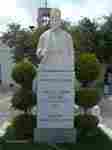

Lykourgos Logothetis, Themistoklis Sofoulis,
More Images See : Samos, Gallery
See also
Pauly-Wissowa
Classical authors:
Xenophon
Municipality Samos(Seat: Σάμος, η, Historic Seat: Πυθαγόρειο, το) |
5601 | 32.977 |
|---|---|---|
| Municipal unit Vathy | 560101 | 12.517 |
| Municipal Community Vathy | 56010104 | 3.147 |
| Agia Zoni (Αγία Ζώνη, η) | 5601010402 | 128 |
| Agia Markella (Αγία Μαρκέλλα, η) | 5601010403 | 7 |
| Agia Triada (Αγία Τριάδα, η) | 5601010404 | 46 |
| Ai Thanasis (Άη Θανάσης, ο) | 5601010405 | 21 |
| Vathy (Βαθύ, το) | 5601010401 | 1.888 |
| Varella (Βαρέλλα, η) | 5601010406 | 106 |
| Drosia (Δροσιά, η) | 5601010407 | 69 |
| Zervou (Ζερβού, η) | 5601010408 | 34 |
| Zoodochos Pigi (Ζωοδόχος Πηγή, η) | 5601010409 | 6 |
| Kamara (Καμάρα, η) | 5601010410 | 258 |
| Kedro (Κέδρον, το) | 5601010411 | 109 |
| Koumarionas (Κουμαριώνας, ο) | 5601010412 | 112 |
| Mesokampos (Μεσόκαμπος, ο) | 5601010413 | 110 |
| Moraitochori (Μωραϊτοχώρι, το) | 5601010414 | 30 |
| Nikola (Νικόλα, η) | 5601010415 | 144 |
| Panaitsa (Παναΐτσα, η) | 5601010416 | 19 |
| Platanos (Πλάτανος, ο) | 5601010417 | 23 |
| Tourkomylonas (Τουρκομυλωνάς, ο) | 5601010418 | 16 |
| Floka (Φλόκα, η) | 5601010419 | 21 |
| Municipal Community Samos | 56010101 | 6.251 |
| Agia Paraskevi (Αγία Παρασκευή, η) | 5601010102 | 26 |
| Agios Nikolaos (Άγιος Νικόλαος, ο (νησίς)) | 5601010103 | 0 |
| Asprochorti (Ασπροχόρτι, το) | 5601010104 | 11 |
| Galazio (Γαλάζιο, το) | 5601010105 | 23 |
| Diaporti (Διαπόρτι, το (νησίς)) | 5601010106 | 0 |
| Kasonisi (Κασονήσι, το (νησίς)) | 5601010107 | 0 |
| Makroniso (Μακρόνησο, το (νησίς)) | 5601010108 | 0 |
| Prasonisi (Πρασονήσιο, το (νησίς)) | 5601010109 | 0 |
| Samos (Σάμος, η) | 5601010101 | 6.191 |
| Strongylo (Στρογγυλό, το (νησίς)) | 5601010110 | 0 |
| Community Agios Konstantinos | 56010102 | 369 |
| Agios Konstantinos (Άγιος Κωνσταντίνος, ο) | 5601010201 | 368 |
| Valeontades (Βαλεοντάδες, οι) | 5601010202 | 1 |
| Community Ampelos | 56010103 | 309 |
| Ampelos (Άμπελος, η) | 5601010301 | 252 |
| Livadaki (Λιβαδάκι, το) | 5601010302 | 28 |
| Petalides (Πεταλίδες, οι) | 5601010303 | 29 |
| Community Vourliotes | 56010105 | 501 |
| Avlakia (Αυλάκια, τα) | 5601010502 | 18 |
| Vourliotes (Βουρλιώται, οι) | 5601010501 | 376 |
| Kampos (Κάμπος, ο) | 5601010503 | 91 |
| Μονή Βροντά, η | 5601010504 | 16 |
| Community Kokkari | 56010106 | 1.060 |
| Kokkari (Κοκκάριον, το) | 5601010601 | 1.060 |
| Community Monolates | 56010107 | 131 |
| Manolates (Μανολάτες, οι) | 5601010701 | 131 |
| Margarites (Μαργαρίτες, οι) | 5601010702 | 0 |
| Community Palaiokastro | 56010108 | 707 |
| Argyros (Αργυρός, ο) | 5601010802 | 45 |
| Klima (Κλήμα, το) | 5601010803 | 26 |
| Palaiokastro (Παλαιόκαστρον, το) | 5601010801 | 502 |
| Poseidonio (Ποσειδώνιον, το) | 5601010804 | 31 |
| Charavgi (Χαραυγή, η) | 5601010805 | 54 |
| Psili Ammos (Ψιλή Άμμος, η) | 5601010806 | 49 |
| Community Stavrinides | 56010109 | 42 |
| Stavrinides (Σταυρινήδες, οι) | 5601010901 | 42 |
| Municipal unit Karlovasi | 560102 | 9.855 |
| Municipal Community Karlovasi | 56010201 | 6.869 |
| Μονή Προφήτου Ηλιού, η | 5601020102 | 97 |
| Neo Karlovasi (Νέο Καρλοβάσι, το) | 5601020101 | 6.708 |
| Ποτάμι, το | 5601020103 | 19 |
| Sakkoulaiika (Σακκουλαίικα, τα) | 5601020104 | 16 |
| Sourides (Σουρήδες, οι) | 5601020105 | 29 |
| Community Agioi Theodoroi | 56010202 | 123 |
| Agioi Theodoroi (Άγιοι Θεόδωροι, οι) | 5601020201 | 123 |
| Community Drakaioi | 56010203 | 112 |
| Drakaioi (Δρακαίοι, οι) | 5601020301 | 89 |
| Όρμος Αγίου Ισιδώρου, ο | 5601020302 | 23 |
| Community Kastania | 56010204 | 164 |
| Kastania (Καστανέα, η) | 5601020401 | 164 |
| Community Kontaiika | 56010205 | 350 |
| Kontaiika (Κονταίικα, τα) | 5601020501 | 350 |
| Community Kontakaiika | 56010206 | 962 |
| Agios Dimitrios (Άγιος Δημήτριος, ο) | 5601020602 | 240 |
| Agios Ilias (Άγιος Ηλίας, ο) | 5601020603 | 33 |
| Agios Nikolaos (Άγιος Νικόλαος, ο) | 5601020604 | 26 |
| Vryses (Βρύσαι, αι) | 5601020605 | 136 |
| Kontakaiika (Κοντακαίικα, τα) | 5601020601 | 527 |
| Chatzistamoulides (Χατζησταμούληδες, οι) | 5601020606 | 0 |
| Community Kosmadaioi | 56010207 | 91 |
| Kosmadaioi (Κοσμαδαίοι, οι) | 5601020701 | 80 |
| Nikoloudes (Νικολούδες, οι) | 5601020702 | 11 |
| Community Leka | 56010208 | 419 |
| Agios Panteleimon (Άγιος Παντελεήμων, ο) | 5601020802 | 7 |
| Leka (Λέκα, η) | 5601020801 | 412 |
| Community Platanos | 56010209 | 396 |
| Platanos (Πλάτανος, ο) | 5601020901 | 396 |
| Community Ydroussa | 56010210 | 369 |
| Ydroussa (Υδρούσσα, η) | 5601021001 | 369 |
| Municipal unit Marathokampos | 560103 | 2.609 |
| Municipal Community Marathokampos | 56010301 | 1.900 |
| Agia Kyriaki (Αγία Κυριακή, η) | 5601030102 | 43 |
| Velanidia (Βελανιδιά, η (Δ.Κ.Μαραθοκάμπου)) | 5601030103 | 72 |
| Isomata (Ισώματα, τα) | 5601030104 | 6 |
| Kampos (Κάμπος, ο (Δ.Κ.Μαραθοκάμπου)) | 5601030105 | 471 |
| Limnionas (Λιμνιώνας, ο) | 5601030106 | 29 |
| Marathokampos (Μαραθόκαμπος, ο) | 5601030101 | 1.069 |
| Όρμος Μαραθοκάμπου, ο | 5601030107 | 194 |
| Palaiochori (Παλαιοχώρι, το) | 5601030108 | 16 |
| Sevastaiika (Σεβασταίικα, τα) | 5601030109 | 0 |
| Community Kallithea | 56010302 | 136 |
| Kallithea (Καλλιθέα, η) | 5601030201 | 136 |
| Community Koumaiika | 56010303 | 376 |
| Βελανιδιά, η (Τ.Κ.Κουμαιίκων) | 5601030302 | 10 |
| Koumaiika (Κουμαίικα, τα) | 5601030301 | 323 |
| Όρμος Κουμαίικων, ο | 5601030303 | 43 |
| Community Neochori | 56010304 | 62 |
| Neochori (Νεοχώρι, το) | 5601030401 | 62 |
| Community Skouraiika | 56010305 | 135 |
| Κάμπος, ο (Τ.Κ.Σκουραιίκων) | 5601030502 | 7 |
| Perri (Πέρρη, η) | 5601030503 | 23 |
| Πεύκος, ο | 5601030504 | 13 |
| Skouraiika (Σκουραίικα, τα) | 5601030501 | 92 |
| Municipal unit Pythagoreio | 560104 | 7.996 |
| Municipal Community Mytilinioi | 56010406 | 2.107 |
| Kamara (Καμάρα, η) | 5601040602 | 3 |
| Moni Agias Triados (Μονή Αγίας Τριάδος, η) | 5601040603 | 19 |
| Mytilinioi (Μυτιληνιοί, οι) | 5601040601 | 1.982 |
| Potami Mesokampou (Ποτάμι Μεσοκάμπου, το) | 5601040604 | 40 |
| Rizovrachos (Ριζοβράχος, ο) | 5601040605 | 63 |
| Municipal Community Pagondas | 56010407 | 1.395 |
| Iraio (Ηραίον, το) | 5601040702 | 849 |
| Kolona (Κολόνα, η) | 5601040703 | 28 |
| Pagondas (Παγώνδας, ο) | 5601040701 | 518 |
| Municipal Community Pythagoreio | 56010401 | 1.500 |
| Karvopoulos (Καρπόβουλος, ο) | 5601040102 | 29 |
| Nea Poli (Νέα Πόλη, η) | 5601040103 | 76 |
| Pountes (Πούντες, οι) | 5601040104 | 123 |
| Pythagoreio (Πυθαγόρειο, το) | 5601040101 | 1.272 |
| Municipal Community Chora | 56010411 | 1.340 |
| Potokaki (Ποτοκάκι, το) | 5601041102 | 122 |
| Chora (Χώρα, η) | 5601041101 | 1.218 |
| Community Koumaradaioi | 56010402 | 130 |
| Koumaradaioi (Κουμαραδαίοι, οι) | 5601040201 | 123 |
| Μονή Μεγάλης Παναγίας, η | 5601040202 | 7 |
| Community Mavratzaioi | 56010403 | 301 |
| Gionides (Γιώνιδες, οι) | 5601040302 | 49 |
| Mavratzaioi (Μαυρατζαίοι, οι) | 5601040301 | 249 |
| Μονή Τιμίου Σταυρού, η | 5601040303 | 3 |
| Community Mesogeio | 56010404 | 109 |
| Mesogeio (Μεσόγειον, το) | 5601040401 | 109 |
| Community Myloi | 56010405 | 248 |
| Myloi (Μύλοι, οι) | 5601040501 | 248 |
| Community Pandroso | 56010408 | 110 |
| Pandroso (Πάνδροσον, το) | 5601040801 | 110 |
| Community Pyrgos | 56010409 | 419 |
| Pyrgos (Πύργος, ο) | 5601040901 | 419 |
| Community Spatharaioi | 56010410 | 337 |
| Avanti (Αβάντι, το) | 5601041002 | 16 |
| Apostolos Pavlos (Απόστολος Παύλος, ο) | 5601041003 | 8 |
| Vergi (Βεργή, η) | 5601041004 | 13 |
| Kalogeriko (Καλογερικό, το) | 5601041005 | 9 |
| Kyrgianni (Κύργιαννη, η) | 5601041006 | 25 |
| Limnonaki (Λιμνονάκι, το) | 5601041007 | 14 |
| Metochi (Μετόχι, το) | 5601041008 | 0 |
| Samiopoula (Σαμιοπούλα, η (νησίς)) | 5601041009 | 4 |
| Spatharaioi (Σπαθαραίοι, οι) | 5601041001 | 236 |
| Sykia (Συκιά, η) | 5601041010 | 12 |
References
^ "Samos Climate Guide" - weather2travel.com
^ [1]
^ Hezekiah's Tunnel was first
^ Chisholm, Hugh, ed (1911). "Samos". Encyclopædia Britannica (11th ed.). Cambridge University Press.
^ Kallikratis reform law textPDF
External material
Westermann, Großer Atlas zur Weltgeschichte (in German)
World Statesmen - Greece
Herodotus, especially book iii.
Pauly-Wissowa (in German, on Antiquity)
Strabo xiv. pp. 636–639
Thucydides, especially books i. and viii.
Xenophon, Hellenica, books i. ii.
Further reading
A. Agelarakis, "Anthropologic Results: The Geometric Period Necropolis at Pythagoreion". Archival Report. Samos Island Antiquities Authority, Greece, (2003).
J. P. Barron, The Silver Coins of Samos (London, 1966).
J. Boehlau, Aus ionischen and italischen Nekropolen (Leipzig, 1898). (E. H. B.; M. 0. B. C.; E. Ga.).
C. Curtius, Urkunden zur Geschichte von Samos (Wesel, 1873).
P. Gardner, Samos and Samian Coins (London, 1882).
V. Guérin, Description de l'île de Patmos et de l'île de Samos (Paris, 1856).
K. Hallof and A. P. Matthaiou (eds), Inscriptiones Chii et Sami cum Corassiis Icariaque (Inscriptiones Graecae, xii. 6. 1–2). 2 vols. (Berolini–Novi Eboraci: de Gruyter, 2000; 2004).
B. V. Head, Historia Numorum (Oxford, 1887), pp. 515–518.
L. E. Hicks and G. F. Hill, Greek Historical Inscriptions (Oxford, 1901), No. 81.
H. Kyrieleis, Führer durch das Heraion von Samos (Athen, 1981).
T. Panofka, Res Samiorum (Berlin, 1822).
T. J. Quinn, Athens and Samos, Chios and Lesbos (Manchester, 1981).
G. Shipley, A History of Samos 800–188 BC (Oxford, 1987).
R. Tölle-Kastenbein, Herodot und Samos (Bochum, 1976).
H. F. Tozer, Islands of the Aegean (London, 1890).
K. Tsakos, Samos: A Guide to the History and Archaeology (Athens, 2003).
H. Walter, Das Heraion von Samos (München, 1976).
Volumes of the Samos series of archaeological reports published by the Deutsches Archäologisches Institut.
1. V. Milojčić, Die prähistorische Siedlung unter dem Heraion (Bonn, 1961).
2. R. C. S. Felsch, Das Kastro Tigani (Bonn, 1988).
3. A. E. Furtwängler, Der Nordbau im Heraion von Samos (Bonn, 1989).
4. H. P. Isler, Das archaische Nordtor und seine Umgebung im Heraion von Samos (Bonn, 1978).
5. H. Walter, Frühe samische Gefäße (Bonn, 1968).
6.1. E. Walter-Karydi, Samische Gefäße des 6. Jahrhunderts v. Chr. (Bonn, 1973).
7. G. Schmidt, Kyprische Bildwerke aus dem Heraion von Samos (Bonn, 1968).
8. U. Jantzen, Ägyptische und orientalische Bronzen aus dem Heraion von Samos (Bonn, 1972).
9. U. Gehrikg, with G. Schneider, Die Greifenprotomen aus dem Heraion von Samos (Bonn, 2004).
10. H. Kyrieleis, Der große Kuros von Samos (Bonn, 1996).
11. B. Freyer-Schauenburg, Bildwerke der archaischen Zeit und des strengen Stils (Bonn, 1974).
12. R. Horn, Hellenistische Bildwerke auf Samos (Bonn, 1972).
14. R. Tölle-Kastenbein, Das Kastro Tigani (Bonn, 1974).
15. H. J. Kienast, Die Stadtmauer von Samos (Bonn, 1978).
16. W. Martini, Das Gymnasium von Samos (Bonn, 1984).
17. W. Martini and C. Streckner, Das Gymnasium von Samos: das frühbyzantinische Klostergut (Bonn, 1993).
18. V. Jarosch, Samische Tonfiguren aus dem Heraion von Samos (Bonn, 1994).
19. H. J. Kienast, Die Wasserleitung des Eupalinos auf Samos (Bonn, 1995).
20. U. Jantzen with W. Hautumm, W.-R. Megow, M. Weber, and H. J. Kienast, Die Wasserleitung des Eupalinos: die Funde (Bonn, 2004).
22. B. Kreuzer, Die attisch schwarzfigurige Keramik aus dem Heraion von Samos (Bonn, 1998).
24.1. T. Schulz with H. J. Kienast, Die römischen Tempel im Heraion von Samos: die Prostyloi (Bonn, 2002).
25. C. Hendrich, Die Säulenordnung des ersten Dipteros von Samos (Bonn, 2007).
| Ancient Greece
Science, Technology , Medicine , Warfare, , Biographies , Life , Cities/Places/Maps , Arts , Literature , Philosophy ,Olympics, Mythology , History , Images Medieval Greece / Byzantine Empire Science, Technology, Arts, , Warfare , Literature, Biographies, Icons, History Modern Greece Cities, Islands, Regions, Fauna/Flora ,Biographies , History , Warfare, Science/Technology, Literature, Music , Arts , Film/Actors , Sport , Fashion --- |
Retrieved from "http://en.wikipedia.org/"
All text is available under the terms of the GNU Free Documentation License


